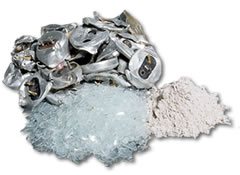Our Recycling Process Ensures Compliance
Lamp Recycling Process
Although there are variations between the equipment used at each Veolia facility all lamp-recycling processes utilize a dry separation process. Each machine is capable of processing 20,000 to 40,000 4 foot lamps per 8 hour shift with an asset recovery rate of greater than 99%. Of total bulb weight, roughly 96% is recovered as glass, 2% as aluminum, less than 2% as phosphor powder and less than 1% as mercury for refining. Routine monitoring of mercury values in all recovered materials, through TCLP and total mercury testing techniques, is standard operating procedure. The system utilizes dry crushing, dry separation and dry filtration operations. Lamps are brought into the recycling area on wrapped pallets, within cardboard boxes or lamp fiber drums. The lamps are brought to the lamp feed staging area where they enter the recycling process. In-feed to the process consists of manually opening the packaged containers and placing the lamps into the feed mechanism. The lamps are conveyed into a chamber where a breaker performs an initial particle size reduction of the lamps. Broken lamp pieces are then crushed to achieve a greater particle size reduction and transferred to a primary separator to separate the larger components (aluminum end caps). The remaining components are then further separated generating three process streams: glass cullet, glass fines, and phosphor powder.
The Vapor Collection System is designed to control mercury vapor and dust emissions from the process. The vapor collection system is comprised of a bag house/cartridge filter equipped with a series of particulate filters, an air compressor for filter back purge, and an activated carbon vessel. The system draws mercury vapor and dust from the process equipment into the bag house. The filter arrangement is designed to trap over 99% of air-borne particles measuring 0.5 microns or larger. Dust accumulates in containers located underneath the bag house. The air stream leaving the bag house then passes through a sulfur-impregnated carbon vessel to further remove mercury vapors. Each stack is monitored using a real-time mercury vapor-monitoring instrument in accordance with facility’s specific operating permit/plan.
Ballast Recycling Process
The transformer sections and metal casings proceed to a process area where additional potting compound is manually removed. The additional potting compound is combined with potting compound previously removed from ballast. Ballast casings are then decontaminated using a physical removal process. The decontaminated casings are next tested to ensure the effectiveness of the decontamination procedure. After analytical results have been received documenting that the casings have been sufficiently decontaminated, the casings are sold as scrap metal. The transformer sections are separated into two categories of material: wire windings and transformer cores. The wire windings are either manually or chemically decontaminated, depending on the facility. The decontaminated wires are also tested to ensure the effectiveness of the decontamination procedure. After analytical results have been received documenting the wires have been sufficiently decontaminated, the wire is sold as a scrap metal.
Battery Recycling Process
Batteries are received and sorted into like chemistry types. Mercury containing batteries are distilled or retorted onsite and the retorted mercury is recovered as a product. All other batteries are shipped to various licensed and approved vendors for reclamation, recovery and recycling.
Mercury Waste Process
All materials received are manually inspected. Preprocessing steps recover valuable non-contaminated recyclables such as glass, metals, and plastics. The remaining contaminated mercury debris is then retorted under vacuum. Retort time, temperature and cycle are dependent upon the composition of material to be retorted. Mercury from the retort operations is collected in a system tank and from this tank, 76-pound or metric ton mercury flasks are filled. Mercury is accumulated and shipped to a mercury supply house for purification and packaged for resale.
E-Waste Process
Electronic equipment is received and sorted into groups by electronic components. All miscellaneous equipment is shipped domestically for re-use, refurbishment, or recycle where monitors are de-manufactured and bald CRTs are shipped to a domestic leaded glass recycler for re-use. Various components, copper, ferrous metal and insulated wire are shipped off site for recycle. Processing units are sorted and refurbished or de-manufactured into precious metals, circuit boards, power supplies and disk drives.
